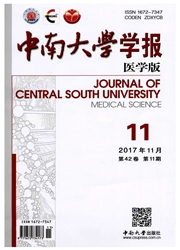

 中文摘要:
中文摘要:
目的:使用酵母双杂交来筛选LRRK2基因的相互作用蛋白,以研究其功能。方法:使用的诱饵片段包含MAPKKK和ROC功能域的一部分与COR功能域的全长。诱饵片段由聚合酶链式反应(PCR)扩增后连入酵母表达质粒pGBKT7,pGBKT7-bait质粒经测序验证后转化酵母菌株AH109,用免疫印迹来检验该质粒在酵母中的表达,人类胎脑cDNA文库被转化到能稳定表达诱饵蛋白的酵母菌株中,并铺到含有X-α-gal的四缺(SD/-Trp/-Leu/-His/-Ade)的培养皿上。分别使用含有pGBKT7或pGBKT7-bait的AH109酵母菌株进行回交检测,进一步确证从初步筛选中获得的阳性克隆,并用生物信息学来分析其中的文库质粒。结果:获得9个真阳性的克隆,经生物信息学分析其中有3个克隆中的序列不在已知基因的开放阅读框内,其余6个克隆中的序列在以下几个已知基因的开放阅读框中:STRBP,BAG5,PTPN23,L3MBTL3,RA-LYL,KIAA1783。结论:经酵母双杂交后成功地获得了真阳性克隆。这些相互作用蛋白将为研究LRRK2的功能、帕金森病发病机制和其他神经性疾病提供一些新的线索。
 英文摘要:
英文摘要:
Objective To isolate and identify the potential binding partners of LRRK2, a gene linked to both dominant familial form and sporadic form of Parkinson ' s disease, thus to further our knowledge of its function. Methods We used a sequence containing full-length of COR domain and part of ROC and MAPKKK domain as bait. The bait amplified by polymerase chain reaction ( PCR ) was then cloned into a yeast expression plasmid pGBKT7. After being sequenced and analyzed, pGBKT7-bait was transformed into the yeast strain AH109. Western blot was performed to confirm the expression of pGBKT7-bait in AH109 yeast strain. Then human fetal brain cDNA library was transformed into that yeast strain, which could express pGBKTT-bait fusion protein. The yeast strain which contained pGBKT7-bait and human fetal brain cDNA library was plated on quadruple dropout medium (SD/-Trp/-Leu/-His/-Ade ) containing X-α-gal. We retested these positive colonies using 2 independent yeast strains AH109 contained pGBKT7-bait or pGBKT7, respectively. At last, these plasraids isolated from these true positive colonies were analyzed by bioinformatics. Results We obtained 9 true positive colonies, these colonies were sequenced, and we performed sequence Blast in GenBank. Three colonies of the 9 positive colonies were not in open reading-frames. Among other 6 colonies, there were known proteins including spermatid perinuclear RNA-binding protein (STRBP) and BCL2 - associated athanogene 5 isoform b (BAG5) , as well as unknown proteins including tyrosine phosphatase non-receptor type ( PTPN23 ) , 1 ( 3 ) mbt-like 3 isoform b ( L3 MBTL3 ), RALY RNA binding protein-like isoform 1 ( RALYL ) , and Homo sapiens mRNA for KIAA 1783 protein, partial cds ( KIAA1783 ). Conclusion True positive colonies of LRRK2 are successfully obtained by the yeast 2- hybrid. Our screened proteins may provide a new research clue for revealing biological functions of LRRK2, pathogenesis of Parkinson ' s disease, and other neurodegerations.
 同期刊论文项目
同期刊论文项目
 同项目期刊论文
同项目期刊论文
 Trafficking abnormality and ER stress underlie functional deficiency of hearing impairment-associate
Trafficking abnormality and ER stress underlie functional deficiency of hearing impairment-associate Regulation of intracellular manganese homeostasis by Kufor-Rakeb syndrome-associated ATP13A2 protein
Regulation of intracellular manganese homeostasis by Kufor-Rakeb syndrome-associated ATP13A2 protein Effect of Antipsychotic Medication Alone vs Combined With Psychosocial Intervention on Outcomes of E
Effect of Antipsychotic Medication Alone vs Combined With Psychosocial Intervention on Outcomes of E No significant association between RELN polymorphism and autism in case-control and family-based ass
No significant association between RELN polymorphism and autism in case-control and family-based ass Genetic screening for mutations in the Nrdp1 gene in Parkinson disease patients in a Chinese populat
Genetic screening for mutations in the Nrdp1 gene in Parkinson disease patients in a Chinese populat 期刊信息
期刊信息
